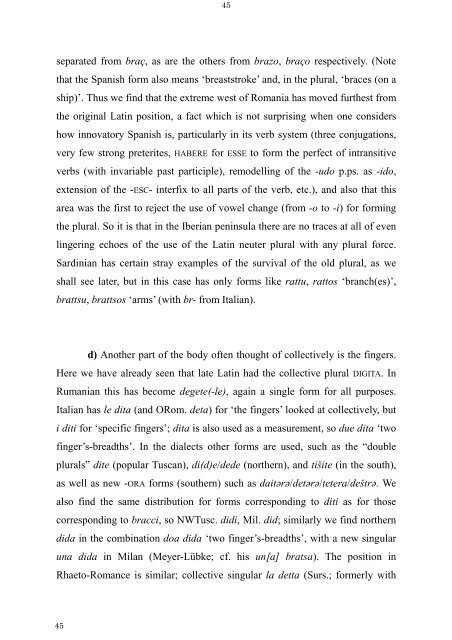The Latin Neuter Plurals in Romance - Page ON
The Latin Neuter Plurals in Romance - Page ON
The Latin Neuter Plurals in Romance - Page ON
Create successful ePaper yourself
Turn your PDF publications into a flip-book with our unique Google optimized e-Paper software.
45<br />
45<br />
separated from braç, as are the others from brazo, braço respectively. (Note<br />
that the Spanish form also means ‘breaststroke’ and, <strong>in</strong> the plural, ‘braces (on a<br />
ship)’. Thus we f<strong>in</strong>d that the extreme west of Romania has moved furthest from<br />
the orig<strong>in</strong>al <strong>Lat<strong>in</strong></strong> position, a fact which is not surpris<strong>in</strong>g when one considers<br />
how <strong>in</strong>novatory Spanish is, particularly <strong>in</strong> its verb system (three conjugations,<br />
very few strong preterites, HABERE for ESSE to form the perfect of <strong>in</strong>transitive<br />
verbs (with <strong>in</strong>variable past participle), remodell<strong>in</strong>g of the -udo p.ps. as -ido,<br />
extension of the -ESC- <strong>in</strong>terfix to all parts of the verb, etc.), and also that this<br />
area was the first to reject the use of vowel change (from -o to -i) for form<strong>in</strong>g<br />
the plural. So it is that <strong>in</strong> the Iberian pen<strong>in</strong>sula there are no traces at all of even<br />
l<strong>in</strong>ger<strong>in</strong>g echoes of the use of the <strong>Lat<strong>in</strong></strong> neuter plural with any plural force.<br />
Sard<strong>in</strong>ian has certa<strong>in</strong> stray examples of the survival of the old plural, as we<br />
shall see later, but <strong>in</strong> this case has only forms like rattu, rattos ‘branch(es)’,<br />
brattsu, brattsos ‘arms’ (with br- from Italian).<br />
d) Another part of the body often thought of collectively is the f<strong>in</strong>gers.<br />
Here we have already seen that late <strong>Lat<strong>in</strong></strong> had the collective plural DIGITA. In<br />
Rumanian this has become degete(-le), aga<strong>in</strong> a s<strong>in</strong>gle form for all purposes.<br />
Italian has le dita (and ORom. deta) for ‘the f<strong>in</strong>gers’ looked at collectively, but<br />
i diti for ‘specific f<strong>in</strong>gers’; dita is also used as a measurement, so due dita ‘two<br />
f<strong>in</strong>ger’s-breadths’. In the dialects other forms are used, such as the “double<br />
plurals” dite (popular Tuscan), di(d)e/dede (northern), and tišite (<strong>in</strong> the south),<br />
as well as new -ORA forms (southern) such as daitərə/detərə/tetera/deštrə. We<br />
also f<strong>in</strong>d the same distribution for forms correspond<strong>in</strong>g to diti as for those<br />
correspond<strong>in</strong>g to bracci, so NWTusc. didi, Mil. did; similarly we f<strong>in</strong>d northern<br />
dida <strong>in</strong> the comb<strong>in</strong>ation doa dida ‘two f<strong>in</strong>ger’s-breadths’, with a new s<strong>in</strong>gular<br />
una dida <strong>in</strong> Milan (Meyer-Lübke; cf. his un[a] bratsa). <strong>The</strong> position <strong>in</strong><br />
Rhaeto-<strong>Romance</strong> is similar; collective s<strong>in</strong>gular la detta (Surs.; formerly with









